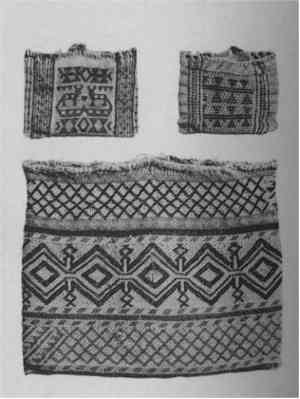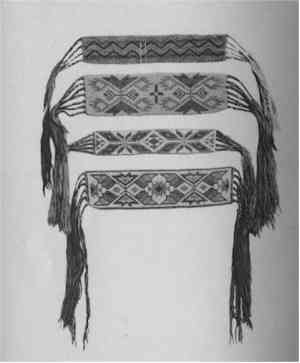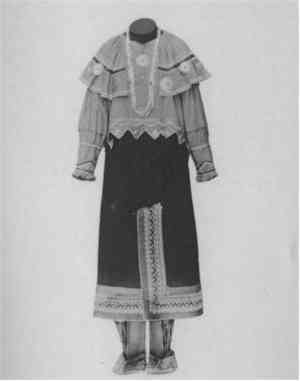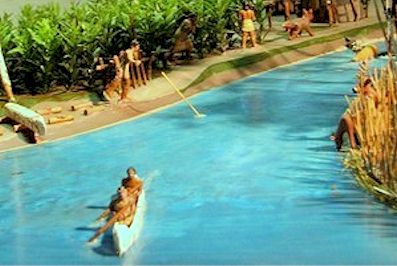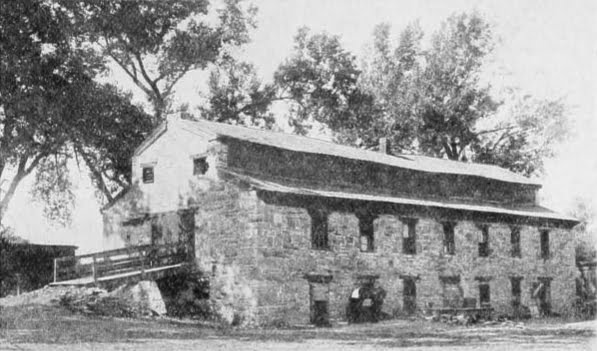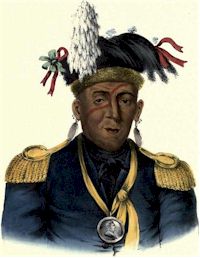Potawatomi Indians, Pottawatomie Indians, Pottawatomie Tribe, Nation of Fire (J. B. Bottineau, speaking Chippewa and Cree fluently, gives Potawatanubñk or Potawaganiñk, i. e. ‘People of the place of the fire,’ as the primary form of the name. This derivation is strongly confirmed by the Huron name Asistagueroüon (Champlain, 1616), for Otsistă’ge`roñnoñ’, likewise signifying ‘People of the place of fire,’ which was applied by them to their enemies who dwelt in 1616 on the west shores of Lake Luron.) The Jesuit Relation for 1671 1 has the following passage: “Four nations make their abode here, namely, those who bear the name Puans (i. e., the Winnebago), who have always lived here as in their own country, and who have been reduced to nothing from being a very flourishing and populous people, having been exterminated by the Illinois, their enemies; the Potawatomi, the Sauk, and the Nation of the Fork (la Fourche) also live here, but as strangers (or foreigners), driven by the fear of Iroquois [The Neuters and Ottawa] from their own lands which are between the lake of the Hurons and that of the Illinois.”
The Jesuit Relations employ the expression “Nation of Fire,” until in the one for 1670 2 occurs the first use of “Makskouteng,” who are represented as living then on Fox River in what is now Wisconsin. Hence, it seems clear that the term “nation of fire” was originally applied to the Potawatomi and their close neighbors, the Sauk and the “Nation of the Fork,” dwelling on the west shore of Lake Huron. And since a part at least of the Potawatomi tribe bears the name Maskotens, officially known as the “Prairie Band,” and the tribe as a whole was a part of those who were called “People of the Fire,” a natural confusion arose as to the application of these two names, and so the term “Fire Nation” at last became permanently affixed to a people whose proper name was ” People of the Small Prairie,” latterly known as the Mascoutens. – Hewitt.
Potawatomi History

An Algonquian tribe, first encountered on the islands of Green Bay, Wisconsin, and at its head. According to the traditions of all three tribes, the Potawatomi, Chippewa, and Ottawa were originally one people, and seem to have reached the region about the upper end of Lake Huron together. Here they separated, but the three have sometimes formed a loose confederacy, or have acted in concert, and in 1846 those removed beyond the Mississippi, asserting their former connection, asked to be again united. Warren conjectured that it had been less than three centuries since the Chippewa became disconnected as a distinct tribe from the Ottawa and Potawatomi. In the Jesuit Relation for 1640 the Potawatomi are spoken of as living in the vicinity of the Winnebago. Verwyst 3 says that in 1641 they were at Sault Ste Marie, fleeing before the Sioux. The Jesuit Relation of 1642, speaking of the meeting of Raymbault and Jogues with the tribes at Sault Ste Marie, says that “a certain nation farther away, which they called Pouteatami, had abandoned its country and taken refuge with the inhabitants of the Sault in order to escape from some other hostile nation which was continually harassing them.” At the “feast of the dead” attended by Raymbault and Jogues in 1641, somewhere east or northeast of Lake Huron, the Chippewa and Potawatomi appear to have been present.
In 1667, Allouez met 300 of their warriors at Chaquamegon Bay. A portion of them were dwelling in 1670 on the islands in the mouth of Green Bay, chiefly about the Jesuit mission of St Francois Xavier. They were then moving southward, and by the close of the 17th century had established themselves on Milwaukee River, at Chicago, and on St Joseph River, mostly in territory that had previously been held by the Miami.
After the conquest of the Illinois, about 1765, they took possession of the part of Illinois lying northeast of the country seized by the Sauk, Foxes, and Kickapoo, at the same time spreading eastward over southern Michigan and gradually approaching the Wabash. At the treaty of Greenville, in 1795, they notified the Miami that they intended to move down upon the Wabash, which they soon afterward did, in spite of the protests of the Miami, who claimed that whole region.
By the beginning of the 19th century they were in possession of the country around the head of Lake Michigan, from Milwaukee River in Wisconsin to Grand River in Michigan, extending southwest over a large part of northern Illinois, east across Michigan to Lake Erie, and south in Indiana to the Wabash and as far down as Pine Creek. Within this territory they had about 50 villages. The principal divisions were those of St Joseph River and Huron River, Michigan, Wabash River, and the Prairie band of Potawatomi in Illinois and Wisconsin.
The Potawatomi sided actively with the French down to the peace of 1763; they were prominent in the rising under Pontiac, and on the breaking out of the Revolution in 1775 took arms against the United States and continued hostilities until the treaty of Greenville in 1795. They again took up arms in the British interest in 1812, and made final treaties of peace in 1815. As the settlements rapidly pressed. upon them, they sell their land by principal, chiefly between the years 1836 and 1841, and removed beyond the Mississippi. A large part of those residing in Indiana refused to leave their homes until driven out by military force. A part of them escaped into Canada and are now settled on Walpole Island in Lake St Clair. Those who went west were settled partly in western Iowa and partly in Kansas, the former, with whom were many individuals of other tribes, being known as Prairie Potawatomi, while the others were known as Potawatomi of the Woods. In 1846 they were all united on a reservation in Kansas. A part of them was known as the Keotuc band. In 1861 a large part of the tribe took lands in severalty and became known as Citizen Potawatomi, but in 1868 they again removed to a tract in Indian Territory (Oklahoma), where they now are. The others are still in Kansas, while a considerable body, part of the Prairie band, is yet in Wisconsin, and another band, the Potawatomi of Huron, is in lower Michigan.
Potawatomi Culture

The Indians of this tribe are described in the early notices as “the most docile and affectionate toward the French of all the savages of the west.” They were also more kindly disposed toward Christianity, besides being more humane and civilized than the other tribes. Tailhan says: “Their natural politeness and readiness to oblige was extended to strangers, which was very rare among these peoples. Up to this time (1864) they have resisted the rum and brandy with which the Anglo-Saxons have poisoned the other tribes.” Sir William Johnson, however, complained in 1772 of robberies and murders committed by them through the intrigues and jealousy of the French traders. Their women were more reserved than was usual among Indians, and showed some tendency toward refinement in manners. The Potawatomi of Milwaukee River, who were considerably intermixed with Sauk and Winnebago, were described about 1825 as being lazy fellows, as a rule preferring to fish and hunt all summer long rather than to cultivate corn, and noted players of the moccasin game and lacrosse, heavy gamblers and given to debauchery. Polygamy was common among the Potawatomi when they were visited by the early missionaries.
According to Schoolcraft, it is believed by the Potawatomi that there are two spirits who govern the world: one is called Kitchemonedo, or the Great Spirit; the other Matchemonedo, or the Evil Spirit; the first is good and beneficent, the other wicked. But all this is the result of Christian teaching. In former times the Potawatomi worshiped the sun to some extent, at least they sometimes offered sacrifice in honor of the sun in order that the sick might recover or that some desire might be obtained. They were accustomed, as were several other tribes of the northwest, to hold what has been called the “feast of dreams,” during which their special or individual manito was selected. Dog meat was the flesh chiefly used at this feast. Burial was probably chiefly by inhumation, though there is some evidence that scaffold exposure was practiced by the western part of the tribe.
Sir Daniel Wilson alludes to certain graves surmounted by small mounds, which the surveyors informed him were Potawatomi burial places. Other graves of the same character found in Iowa are also known to have been burial places of people of the same tribe. Cremation was sometimes resorted to, but this appears to have been limited exclusively to those belonging to the Rabbit gens. About the year 1825 many of them took up the doctrine of the Kickapoo prophet Kanakuk. The Potawatomi have a tendency to elide vowels and syllables, due to the rapidity with which the dialect is spoken as compared with that of the Ottawa and the Chippewa 4.
The tribe probably never greatly exceeded 3,000 souls, and most estimates place them far below that number. The principal estimates give them about 1,500 in 1765, 1,750 in 1766, 2,250 in 1778, 2,000 in 1783, 1,200 in 1795, 2,500 in 1812, 3,400 in 1820, and 1,800 in 1843. The last estimate does not include those who had recently fled to Canada. In 1908 those in the United States were reported to number 2,522, distributed as follows:
- Citizen Potawatomi in Oklahoma, 1,768;
- Prairie band in Kansas, 676; and
- Potawatomi of Huron, in Calhoun co., Mich., 78.
A few besides these are scattered through their ancient territory and at various other points. Those in British territory are all in the province of Ontario and number about 220, of whom 176 are living with Chippewa and Ottawa on Walpole Island in Lake St Clair, and the remainder (no longer officially reported) are divided between Caradoc and Riviere aux Sables, where, they reside by permission of the Chippewa and Munsee.
For Further Study
The following articles and manuscripts will shed additional light on the Potawatomi as both an ethnological study, and as a people.
- For the migration of the Potawatomi from Michigan, see the Sauk Tribe.
Potowatomi Gallery
Citations:
- Jesuit Relation for 1671, 42, 1858[↩]
- Jesuit Relation for 1671, p. 94[↩]
- Verwyst, Missionary Labors, 211, 1886[↩]
- W. Jones, inf’n, 1906[↩]

